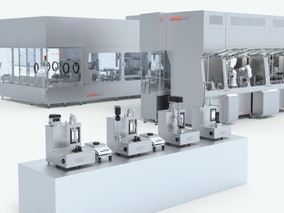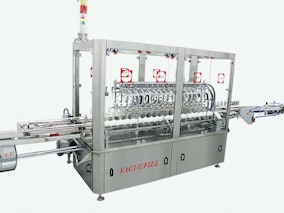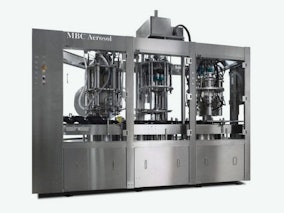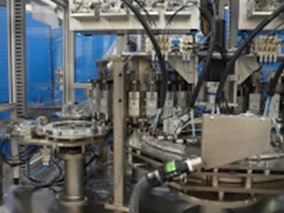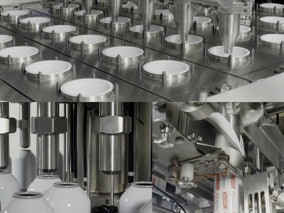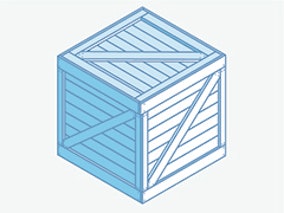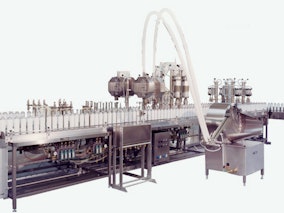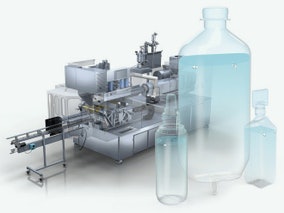Aerosol & Dispensing Filling System
(8 companies)Machines that fill liquid substances into a container so that the substance can be released as a spray using an actuator that is mechanically primed or uses compressed gas as the propellant. Are you considering purchasing new filling, capping or closing machinery? Learn more about what to look for in your next purchase.
-

Bausch + Stroebel Machine Company Inc.
Bausch & Stroebel Machine offers liquid filling systems for pharmaceutical production applications. Featured products from its extensive line include the AFV filling and closing of ampoules and vials, which uses rotary piston pumps in continuous, intermittent-motion rotary machines as well as intermittent-motion linear formats.
You are currently not logged in -

Capmatic Ltd.
Capmatic supplies an extensive range of liquid filling machines for a wide variety of applications from pharmaceutical to food and beverage applications and beyond. Capmatic offers machines with inline, pressure, gravity fill, piston, peristaltic, piston, gravity, tare in/tare out filling technologies ranging from tabletop units to monobloc configurations. Featured amongst Capmatic’s dozens of liquid fillers is Vacufill, an automatic vacuum filler for liquid, semi-viscous and foamy products that is designed as a closed-loop system with negative pressure for applications including filling oils, perfumes, and nail polish.
You are currently not logged in -

MBC Aerosol
MBC Aerosol offers High Speed Rotary (HSR) automated, continuous motion filling machinery for aerosols in cans in 6, 9, 12, and 18 head turret designs. The MBC stations are mounted to a central column uniformly by function. The center column turns continuously with the change part providing an operating time beginning when the head engages the can to the point of can discharge. This method allows for the highest performance of all machines offered. HSR machines are configurable with clockwise rotation left to right or counterclockwise rotation right to left. These machines are capable of operation at a rate up to 300 cans per minute. Other speeds available upon request.
You are currently not logged in -

Norwalt
Norwalt partners with servo-controlled pump manufacturers and peristaltic pump makers to meet the liquid filling needs of its customers, whether the application is a medical device, a commercial product, or a cosmetic product. Filling machines feature: patented continuous motion and indexing for higher speeds, vision inspection integration to verify fill heights and peristaltic and servo controlled positive displacement dispensing pumps for precision filling.
You are currently not logged in
-

R.A Jones
R.A Jones makes filling equipment for aerosol, chub, and cup packaged products. Autoprod filling systems fill cups, tubs, trays and jars up to 840 cups per minute. Handles liquid and viscous products of various types such as yogurt, ice cream, dips, butter, soups, and more. In addition to high speeds, equipment boasts CIP, volumetric and flowmeter filling options and extended shelf life with R.A. Jones’ patented MAP system. KP-Aerofill aerosol equipment is available in single units for lab testing or complete aerosol lines running up to 600 cans per minute.
You are currently not logged in -

SIGMA Equipment, Inc.
SIGMA Equipment offers a broad selection of used liquid filling machines catering to diverse industries, including food, beverage, cosmetics, and pharmaceuticals. Their inventory features equipment capable of handling products of various viscosities, from water-like liquids to thicker substances like creams and pastes. The offerings include volumetric, gravity, overflow, piston, and pump fillers, ensuring precise and efficient dispensing for containers of all shapes and sizes. With options suitable for small-scale operations to high-speed automated production lines, SIGMA provides flexible solutions to meet specific operational needs. Browse SIGMA's current machinery on sale at the link below.
You are currently not logged in -

Terco Inc.
Terco specializes in manufacturing aerosol filling machines and aerosol manufacturing equipment, as well as bag on valve (BOV) aerosol machines. Featured machines include the Model DL Double Line filling system, a double lane indexing filling machine for the production of aerosol products up to 140 cans per minute. The systems can be configured in either Double Line Single Indexing (DLSI) with speeds up to 80 cans per minute, or Double Line Double Indexing (DLDI) with speeds up to 140 cans per minute. With single indexing systems, the tables can be pre-drilled for a future upgrade to double indexing to meet future capacity needs. Numerous other aerosol filling models, ranging from manual to semi-automatic indexing machines, are also available.
You are currently not logged in -

Weiler Engineering, Inc.
Weiler Engineering, Inc.’s Asep-Tech blow/fill/seal machines produce plastic aseptically packaged sterile-filled containers in a manner of seconds. Fill volumes range from 0.2mL vials to 1000mL LVP bottles. Typical resins used are LDPE, HDPE and PP.
You are currently not logged in
Report an Issue
Incorrect/inaccurate categorization? Report inaccuracies or problems »
Related Liquid Fillers searches
More on Aerosol & Dispensing Filling System
Aerosol technology uses compressed air or other propellants to dispense a liquid product in a fine mist or spray. This is particularly useful for personal care products such as hairspray and deodorant, food products like cooking oils and whipping cream or pharmaceutical products, like asthma inhalers, where a fine mist is necessary for even application or effective dosing. The aerosol canister is filled with the liquid product, followed by the propellant, which is added under pressure. When the valve is pressed, the propellant is released, forcing the product out with it.
Aerosol liquid filling systems use a pump or other mechanism to dispense a product in a controlled manner. These systems are better suited for thicker products, such as lotions, creams and gels, where a precise amount of product needs to be dispensed. The contents are stored in a container that has a pump or other mechanism attached, and when the user presses it, the product is dispensed.
The machines used to fill aerosol cans are particularly highly specialized and complex. One such machine is the Bag on Valve (BOV) packaging machine, which uses a unique technology to separate the product from the propellant, which allows it to be stored in a flexible bag inside of the can.
Other types of machines used to fill compressed gas canisters are the crimper gasser, which is used to seal and pressurize the cans, and shaker gassers, which mix and pressurize the products, ensuring that they are evenly distributed throughout the can.
Both aerosol and dispensing filling systems have a number of advantages over more traditional packaging methods. For one, they allow for precise and controlled dispensing of products, which reduces waste and improves efficiency. They also make it much more user-friendly, as the exact amount of product they need will be portioned out without having to measure or estimate.
Another advantage of these packaging formats is that they extend the shelf life of products. Their mechanism of dispensing liquid products in a controlled and precise mist or spray helps to reduce exposure to air and other contaminants, which can cause products to degrade over time. This can be particularly important for products such as medications, which need controlled storage to maintain their effectiveness.
Aerosol and dispensing filling systems can also be more environmentally friendly than traditional packaging methods. For starters, they can reduce consumer waste by ensuring that users only dispense the amount of product they need. They also often use less packaging material than traditional methods, which can help to reduce the environmental impact of the packaging process at the production level.
As a whole, aerosol and dispensing filling systems have a number of advantages over traditional packaging methods, including enhanced precision, reduced waste and increased shelf life. For many products, these packaging formats are essential, as no other type satisfies this specific need.
If you have a product that already uses or could be well suited by aerosol or dispensing filling systems, we have a directory of vetted and verified OEMs and suppliers right here on PMMI ProSource that are ready to get you started. Browse today.
